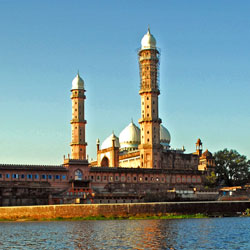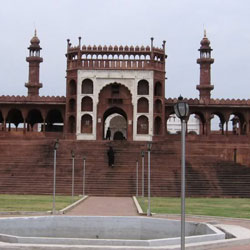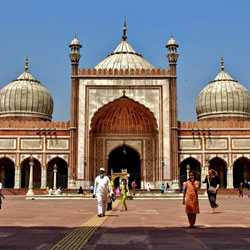
- Home
- Travel Packages
- Top Destination
-
Travel Attraction
By Category
Top Attraction

- Travel Agents
- Car Rentals
- Hotels

About The Taj ul Masjid The Taj ul Masjid, located in Bhopal, is one of the largest mosques in India. The name "Taj ul Masjid" translates to "Crown of Mosques" in English. It is not only a place of worship but also a significant architectural marvel that showcases the rich Islamic heritage of the region. The mosque's grandeur and beauty attract visitors from all over the country and the world. Architecture of Taj ul Masjid The architecture of Taj ul Masjid is a stunning blend of Mughal and Islamic styles. The mosque features colossal domes, minarets, and marble flooring that adds to its magnificence. The intricate carvings, calligraphy, and geometric patterns on the walls and ceilings of the mosque are awe-inspiring. The grand courtyard can accommodate thousands of worshippers during prayers, making it a sight to behold. History The construction of the Taj ul Masjid began in the 19th century during the reign of the Begum Shah Jahan of Bhopal. However, due to lack of funding, the mosque remained incomplete for several decades. It was finally finished in the 1980s, making it one of the most recent mosques of its kind in India. The history of the mosque is deeply intertwined with the history of Bhopal and its rulers. Best Time To Visit The best time to visit the Taj ul Masjid is during the cooler months of October to March when the weather is pleasant and ideal for exploring the mosque. Avoid visiting during extreme summers as the temperatures can soar, making it uncomfortable to wander around the premises. It is recommended to visit early in the morning or late in the afternoon to avoid crowds and witness the serenity of the mosque. How To Reach The Taj ul Masjid is easily accessible from various parts of Bhopal. The nearest airport is Raja Bhoj Airport, which is approximately 11 kilometers away from the mosque. Bhopal Junction Railway Station is the closest railway station, located around 6 kilometers from the mosque. Visitors can hire a taxi, auto-rickshaw, or take a local bus to reach the Taj ul Masjid conveniently. Visitor Tips 1. Dress modestly and respectfully when visiting the mosque. It is advisable to cover your head and shoulders before entering the premises. 2. Remove your shoes before entering the mosque as a sign of respect. Shoe racks are provided for visitors to store their footwear securely. 3. Photography is allowed outside the mosque, but avoid taking pictures inside during prayers or religious ceremonies. Respect the sanctity of the place and the worshippers. 4. Maintain silence and avoid making loud noises while inside the mosque. It is a place of worship and tranquility, so be mindful of your surroundings. 5. Take time to appreciate the architecture, design, and ambiance of the Taj ul Masjid. Explore the intricate details and soak in the spiritual atmosphere of this magnificent structure. In conclusion, the Taj ul Masjid in Bhopal is not just a mosque but a symbol of architectural brilliance and religious significance. Visiting this grand structure is a must-do for anyone interested in history, culture, and spirituality. Plan your trip to the Taj ul Masjid and experience the splendor of this "Crown of Mosques" in the heart of India.
Explore More
About The Taj-ul-Masjid The Taj-ul-Masjid, located in Bhopal, India, is one of the largest mosques in the country. Its name translates to "Crown of Mosques" and it is a prominent landmark in the city. This grand mosque was built by Nawab Shah Jahan Begum of Bhopal during the late 19th century and is known for its impressive architecture and cultural significance. Architecture of Taj-ul-Masjid The architecture of Taj-ul-Masjid is a blend of Mughal and Islamic styles, with its pink façade, white domes, and towering minarets that add to its grandeur. The mosque boasts a vast courtyard, a large prayer hall, and intricately designed pillars and arches. The impressive central dome is one of the largest in the world, making it a sight to behold for visitors. History The construction of Taj-ul-Masjid began in the 19th century under the reign of Nawab Shah Jahan Begum, but due to financial constraints, the mosque was not completed until the 1970s. Today, it stands as a symbol of Islamic architecture and the rich cultural heritage of Bhopal. Best Time To Visit The best time to visit Taj-ul-Masjid is during the winter months from October to March when the weather is pleasant and conducive for sightseeing. The mosque is open to visitors throughout the year, but it is advisable to avoid visiting during the summer months when temperatures can soar. How To Reach Taj-ul-Masjid is easily accessible by various modes of transportation. The mosque is located in the heart of Bhopal city, making it convenient for visitors to reach. Bhopal has a well-connected network of roads, railways, and airways, with regular buses, trains, and flights to and from major cities in India. Visitor Tips When visiting Taj-ul-Masjid, it is important to dress modestly and respect the customs and traditions of the mosque. Visitors are required to remove their shoes before entering the prayer hall and women are encouraged to cover their heads. Photography is allowed outside the mosque, but it is advisable to seek permission before taking pictures inside. It is also recommended to visit during non-prayer times to avoid disrupting worshippers. In conclusion, Taj-ul-Masjid is not only a place of worship but also a symbol of Bhopal's rich cultural heritage and architectural prowess. Its stunning design and historical significance make it a must-visit destination for tourists and locals alike.
Explore More
About The Moti Masjid The Moti Masjid, also known as the Pearl Mosque, is a beautiful mosque located in the heart of Bhopal, India. It was built in the 19th century by Sikander Begum, the daughter of Qudsia Begum, in the year 1860. The mosque is an architectural marvel that showcases the rich cultural heritage of the region. Architecture of Moti Masjid The Moti Masjid is made of pristine white marble, which gives it a pearl-like appearance hence its name. The mosque features three stunning domes with intricate carvings and geometric patterns. The facade of the mosque is adorned with delicate designs and calligraphy, adding to its grandeur. The interior of the mosque is equally impressive, with a spacious prayer hall lined with pillars and arches, creating a sense of serenity and tranquility. History The Moti Masjid was commissioned by Sikander Begum, the Sultan of Bhopal, as a place of worship for the royal family. The construction of the mosque was completed in 1860, and it has since served as a significant religious and cultural landmark in the city. Over the years, the Moti Masjid has been well-maintained and preserved, allowing visitors to admire its exquisite architecture and historical significance. Best Time To Visit The best time to visit the Moti Masjid is during the winter months, from October to March, when the weather is pleasant and ideal for sightseeing. The cool temperatures make it comfortable to explore the mosque and appreciate its beauty without the sweltering heat of the summer months. Additionally, visiting in the early morning or late afternoon allows you to avoid the crowds and enjoy a peaceful experience at the mosque. How To Reach The Moti Masjid is located in the heart of Bhopal, making it easily accessible by various modes of transportation. If you are traveling by air, the nearest airport is Raja Bhoj Airport, which is approximately 13 kilometers away from the mosque. You can also reach the mosque by train, as Bhopal Junction is well-connected to major cities in India. For those traveling by road, there are plenty of buses and taxis available to reach the Moti Masjid within the city. Visitor Tips When visiting the Moti Masjid, it is essential to dress modestly and respect the religious customs of the mosque. Make sure to remove your shoes before entering the prayer hall and maintain a quiet and peaceful demeanor while inside. It is also recommended to hire a local guide who can provide you with insights into the history and architecture of the mosque. Lastly, don't forget to bring a camera to capture the stunning beauty of the Moti Masjid and create lasting memories of your visit.
Explore More
About The Jama Masjid The Jama Masjid in Bhopal is a striking example of Mughal architecture that serves as a significant religious and cultural landmark in the city. Built in 1837 by Qudsia Begum, the first female ruler of Bhopal, the mosque is known for its grandeur and intricate design. It is one of the largest mosques in India and can accommodate thousands of worshippers. Architecture of Jama Masjid The Jama Masjid features a blend of Islamic and Indian architectural styles, with its stunning domes, minarets, and intricate carvings. The main prayer hall is adorned with beautiful marble flooring, ornate pillars, and delicate calligraphy on the walls. The mosque's courtyard is spacious and provides a peaceful setting for worshippers to gather. History The Jama Masjid has a rich history that dates back to the early 19th century. It was commissioned by Qudsia Begum, also known as Gohar Begum, who was the ruler of Bhopal from 1819 to 1837. She was a patron of the arts and culture and wanted to leave behind a lasting legacy in the form of a grand mosque for the people of Bhopal. Best Time To Visit The best time to visit the Jama Masjid in Bhopal is during the cooler months of October to March when the weather is pleasant and ideal for exploring the mosque and its surroundings. Visitors can also witness various religious ceremonies and events that take place at the mosque during this time. How To Reach The Jama Masjid is located in the heart of Bhopal city, making it easily accessible by public transportation. Visitors can take a taxi, auto-rickshaw, or local bus to reach the mosque. The nearest railway station is Bhopal Junction, which is just a short drive away from the mosque. Visitor Tips When visiting the Jama Masjid, it is important to dress modestly and respectfully, covering arms and legs. It is also recommended to remove shoes before entering the mosque. Visitors should be mindful of their behavior and maintain silence while inside the prayer hall to respect the worshippers. Photography may be restricted in certain areas, so it is advisable to ask for permission before taking pictures. Overall, the Jama Masjid in Bhopal is a must-visit destination for history buffs, architecture enthusiasts, and those seeking a spiritual experience in a serene setting. Its grandeur and cultural significance make it a truly remarkable landmark in the city of Bhopal, showcasing the rich heritage and architectural beauty of India.
Explore More
About The Dargah-e-Hakimi The Dargah-e-Hakimi, located in Burhanpur, is a renowned Islamic shrine dedicated to Sayyedna Hakimuddin Surur, a revered saint of the Dawoodi Bohra community. The Dargah holds significant religious and historical importance and attracts devotees from far and wide who come to seek blessings and pay their respects. Architecture of Dargah-e-Hakimi The Dargah-e-Hakimi features exquisite Indo-Islamic architecture with intricate designs, marble domes, and ornate carvings that showcase the rich cultural heritage of the region. The shrine is adorned with beautiful pillars, arches, and floral motifs, creating a serene and spiritual ambiance for visitors. History The history of the Dargah-e-Hakimi dates back to the 16th century when Sayyedna Hakimuddin Surur, a prominent spiritual leader, was laid to rest at the site. Over the years, the shrine has been expanded and renovated, becoming a symbol of religious harmony and cultural unity in Burhanpur. Best Time To Visit The best time to visit the Dargah-e-Hakimi is during the annual Urs festival, which is held to commemorate the death anniversary of Sayyedna Hakimuddin Surur. The festival is marked by prayers, rituals, and cultural performances, offering a unique opportunity to experience the spiritual vibrancy of the shrine. How To Reach The Dargah-e-Hakimi is easily accessible by road, rail, and air. Burhanpur is well-connected to major cities in Madhya Pradesh and neighboring states, making it convenient for visitors to reach the shrine. The nearest railway station is Burhanpur Junction, which is just a short distance away from the Dargah. Visitor Tips 1. Dress modestly and respectfully when visiting the Dargah-e-Hakimi. 2. Remove your shoes before entering the shrine as a sign of respect. 3. Follow the customs and traditions observed at the Dargah to avoid causing offense. 4. Seek permission before taking photographs inside the shrine. 5. Plan your visit during the Urs festival to witness the cultural festivities and religious ceremonies.
Explore More5D - 4N Madhya Pradesh Tour Package
5 Days/ 4 Night
Bhopal - Indore - Ujjain - Sanchi
Ujjain - Mahakaaleshwar - Omkareshwar Jyotirlinga Tour Package
3 Days/ 2 Night
Indore
Madhya Pradesh Tour Package 5D - 4N
5 Days/ 4 Night
Bhopal - Indore - Ujjain - Sanchi
Mystic Khajuraho Getaway from Lucknow
3 Days/ 2 Night
Khajuraho